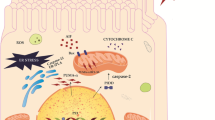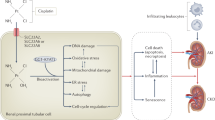Abstract
Cisplatin (CDDP) is one of the most important chemotherapeutic drugs in modern oncology. However, its use is limited by severe toxicities, which impair life quality after cancer. Here, we investigated the role of organic cation transporters (OCT) in mediating toxicities associated with chronic (twice the week for 4 weeks) low-dose (4 mg/kg body weight) CDDP treatment (resembling therapeutic protocols in patients) of wild-type (WT) mice and mice with OCT genetic deletion (OCT1/2−/−). Functional and molecular analysis showed that OCT1/2−/− mice are partially protected from CDDP-induced nephrotoxicity and peripheral neurotoxicity, whereas ototoxicity was not detectable. Surprisingly, proteomic analysis of the kidneys demonstrated that genetic deletion of OCT1/2 itself was associated with significant changes in expression of proinflammatory and profibrotic proteins which are part of an OCT-associated protein network. This signature directly regulated by OCT consisted of three classes of proteins, viz., profibrotic proteins, proinflammatory proteins, and nutrient sensing molecules. Consistent with functional protection, CDDP-induced proteome changes were more severe in WT mice than in OCT1/2−/− mice. Laser ablation-inductively coupled plasma-mass spectrometry analysis demonstrated that the presence of OCT was not associated with higher renal platinum concentrations. Taken together, these results redefine the role of OCT from passive membrane transporters to active modulators of cell signaling in the kidney.






Similar content being viewed by others
References
Albers JW, Chaudhry V, Cavaletti G, Donehower RC (2011) Interventions for preventing neuropathy caused by cisplatin andrelated compounds. Cochrane Database Syst Rev. https://doi.org/10.1002/14651858.CD005228.pub3
Bartram MP, Habbig S, Pahmeyer C, Hohne M, Weber LT, Thiele H, Altmuller J et al (2016) Three-layered proteomic characterization of a novel ACTN4 mutation unravels its pathogenic potential in FSGS. Hum Mol Genet 25:1152–1164
Carozzi VA, Canta A, Oggioni N, Sala B, Chiorazzi A, Meregalli C, Bossi M et al (2010) Neurophysiological and neuropathological characterization of new murine models of chemotherapy-induced chronic peripheral neuropathies. Exp Neurol 226:301–309
Ciarimboli G (2011) Role of organic cation transporters in drug-induced toxicity. Expert Opin Drug Metab Toxicol 7:159–174
Ciarimboli G, Deuster D, Knief A, Sperling M, Holtkamp M, Edemir B, Pavenstädt H et al (2010) Organic cation transporter 2 mediates cisplatin-induced oto- and nephrotoxicity and is a target for protective interventions. Am J Pathol 176:1169–1180
Cox J, Mann M (2008) MaxQuant enables high peptide identification rates, individualized p.p.b.-range mass accuracies and proteome-wide protein quantification. Nat Biotechnol 26:1367–1372
Cox J, Mann M (2012) 1D and 2D annotation enrichment: a statistical method integrating quantitative proteomics with complementary high-throughput data. BMC Bioinform 13:S12
Cox J, Hein MY, Luber CA, Paron I, Nagaraj N, Mann M (2014) Accurate proteome-wide label-free quantification by delayed normalization and maximal peptide ratio extraction, termed MaxLFQ. Mol Cell Proteomics 13:2513–2526
Einhorn LH (2002) Curing metastatic testicular cancer. Proc Natl Acad Sci USA 99:4592–4595
Fuertes MA, Alonso C, Perez JM (2003) Biochemical modulation of Cisplatin mechanisms of action: enhancement of antitumor activity and circumvention of drug resistance. Chem Rev 103:645–662
Gage GJ, Kipke DR, Shain W (2012) Whole animal perfusion fixation for rodents. J Vis Exp. https://doi.org/10.3791/3564
Hardie NA, MacDonald G, Rubel EW (2004) A new method for imaging and 3D reconstruction of mammalian cochlea by fluorescent confocal microscopy. Brain Res 1000:200–210
Harrach S, Ciarimboli G (2015) Role of transporters in the distribution of platinum-based drugs. Front Pharmacol 6:85
Holle SK, Ciarimboli G, Edemir B, Neugebauer U, Pavenstädt H, Schlatter E (2011) Properties and regulation of organic cation transport in freshly isolated mouse proximal tubules analyzed with a fluorescence reader-based method. Pflugers Arch 462:359–369
Houjou T, Nakano K, Ike O, Wada H, Hitomi S, Shinmi Y, Danno N et al (1996) Oral sustained-release cisplatin capsule. J Pharm Pharmacol 48:474–478
Hucke A, Ciarimboli G (2016) The role of transporters in the toxicity of chemotherapeutic drugs: focus on transporters for organic cations. J Clin Pharmacol 56(Suppl 7):S157–S172
Iglesias JM, Morgan RO, Jenkins NA, Copeland NG, Gilbert DJ, Fernandez MP (2002) Comparative genetics and evolution of annexin A13 as the founder gene of vertebrate annexins. Mol Biol Evol 19:608–618
Jacobs C, Coleman CN, Rich L, Hirst K, Weiner MW (1984) Inhibition of cis-diamminedichloroplatinum secretion by the human kidney with probenecid. Cancer Res 44:3632–3635
Jamesdaniel S (2014) Downstream targets of Lmo4 are modulated by cisplatin in the inner ear of Wistar rats. PLoS One 9:e115263
Jonker JW, Wagenaar E, Van Eijl S, Schinkel AH (2003) Deficiency in the organic cation transporters 1 and 2 (Oct1/Oct2 [Slc22a1/Slc22a2]) in mice abolishes renal secretion of organic cations. Mol Cell Biol 23:7902–7908
Köppen C, Reifschneider O, Castanheira I, Sperling M, Karst U, Ciarimboli G (2015) Quantitative imaging of platinum based on laser ablation-inductively coupled plasma-mass spectrometry to investigate toxic side effects of cisplatin. Metallomics 7:1595–1603
Lanvers-Kaminsky C, Sprowl JA, Malath I, Deuster D, Eveslage M, Schlatter E, Mathijssen RH et al (2015) Human OCT2 variant c.808G > T confers protection effect against cisplatin-induced ototoxicity. Pharmacogenomics 16:323–332
Lariviere R, Gauthier-Bastien A, Ung RV, St-Hilaire J, Mac-Way F, Richard DE, Agharazii M (2017) Endothelin type A receptor blockade reduces vascular calcification and inflammation in rats with chronic kidney disease. J Hypertens 35:376–384
Latcha S, Jaimes EA, Patil S, Glezerman IG, Mehta S, Flombaum CD (2016) Long-term renal outcomes after cisplatin treatment. Clin J Am Soc Nephrol 11:1173–1179
Lau AH (1999) Apoptosis induced by cisplatin nephrotoxic injury. Kidney Int 56:1295–1298
Li J, Xu Z, Jiang L, Mao J, Zeng Z, Fang L, He W et al (2014) Rictor/mTORC2 protects against cisplatin-induced tubular cell death and acute kidney injury. Kidney Int 86:86–102
Liang ZD, Long Y, Tsai WB, Fu S, Kurzrock R, Gagea-Iurascu M, Zhang F et al (2012) Mechanistic basis for overcoming platinum resistance using copper chelating agents. Mol Cancer Ther 11:2483–2494
Liu JJ, Jamieson SM, Subramaniam J, Ip V, Jong NN, Mercer JF, McKeage MJ (2009) Neuronal expression of copper transporter 1 in rat dorsal root ganglia: association with platinum neurotoxicity. Cancer Chemother Pharmacol 64:847–856
Marmiroli P, Riva B, Pozzi E, Ballarini E, Lim D, Chiorazzi A, Meregalli C et al (2017) Susceptibility of different mouse strains to oxaliplatin peripheral neurotoxicity: phenotypic and genotypic insights. PLoS One 12:e0186250
Nakamura T, Yonezawa A, Hashimoto S, Katsura T, Inui KI (2010) Disruption of multidrug and toxin extrusion MATE1 potentiates cisplatin-induced nephrotoxicity. Biochem Pharmacol 80:1762–1767
Pepper RJ, Wang HH, Rajakaruna GK, Papakrivopoulou E, Vogl T, Pusey CD, Cook HT et al (2015) S100A8/A9 (calprotectin) is critical for development of glomerulonephritis and promotes inflammatory leukocyte-renal cell interactions. Am J Pathol 185:1264–1274
Phanish MK, Wahab NA, Colville-Nash P, Hendry BM, Dockrell ME (2006) The differential role of Smad2 and Smad3 in the regulation of pro-fibrotic TGFbeta1 responses in human proximal-tubule epithelial cells. Biochem J 393:601–607
Qian C, Johs A, Chen H, Mann BF, Lu X, Abraham PE, Hettich RL et al (2016) Global proteome response to deletion of genes related to mercury methylation and dissimilatory metal reduction reveals changes in respiratory metabolism in geobacter sulfurreducens PCA. J Proteome Res 15:3540–3549
Rabik CA, Dolan ME (2007) Molecular mechanisms of resistance and toxicity associated with platinating agents. Cancer Treat Rev 33:9–23
Rappsilber J, Ishihama Y, Mann M (2003) Stop and go extraction tips for matrix-assisted laser desorption/ionization, nanoelectrospray, and LC/MS sample pretreatment in proteomics. Anal Chem 75:663–670
Reifschneider O, Wehe CA, Raj I, Ehmcke J, Ciarimboli G, Sperling M, Karst U (2013) Quantitative bioimaging of platinum in polymer embedded mouse organs using laser ablation ICP-MS. Metallomics 5:1440–1447
Rinschen MM, Bharill P, Wu X, Kohli P, Reinert MJ, Kretz O, Saez I et al (2016) The ubiquitin ligase Ubr4 controls stability of podocin/MEC-2 supercomplexes. Hum Mol Genet 25:1328–1344
Rybak LP, Ramkumar V (2007) Ototoxicity. Kidney Int 72:931–935
Sharp CN, Siskind LJ (2017) Developing better mouse models to study cisplatin-induced kidney injury. Am J Physiol Renal Physiol 313:F835–F841
Sprowl JA, Ciarimboli G, Lancaster CS, Giovinazzo H, Gibson AA, Du G, Janke LJ et al (2013) Oxaliplatin-induced neurotoxicity is dependent on the organic cation transporter OCT2. Proc Natl Acad Sci USA 110:11199–11204
Tusher VG, Tibshirani R, Chu G (2001) Significance analysis of microarrays applied to the ionizing radiation response. Proc Natl Acad Sci USA 98:5116–5121
Tyanova S, Temu T, Sinitcyn P, Carlson A, Hein MY, Geiger T, Mann M et al (2016) The Perseus computational platform for comprehensive analysis of (prote)omics data. Nat Methods 13:731–740
Vizcaino JA, Deutsch EW, Wang R, Csordas A, Reisinger F, Rios D, Dianes JA et al (2014) ProteomeXchange provides globally coordinated proteomics data submission and dissemination. Nat Biotechnol 32:223–226
Vizcaino JA, Csordas A, Del-Toro N, Dianes JA, Griss J, Lavidas I, Mayer G et al (2016) 2016 update of the PRIDE database and its related tools. Nucleic Acids Res 44:D447–D456
Vogel GF, Ebner HL, de Araujo ME, Schmiedinger T, Eiter O, Pircher H, Gutleben K et al (2015) Ultrastructural morphometry points to a new role for LAMTOR2 in regulating the endo/lysosomal system. Traffic 16:617–634
Wang D, Lippard SJ (2005) Cellular processing of platinum anticancer drugs. Nat Rev Drug Discov 4:307–320
Xu X, Duan L, Zhou B, Ma R, Zhou H, Liu Z (2012) Genetic polymorphism of copper transporter protein 1 is related to platinum resistance in Chinese non-small cell lung carcinoma patients. Clin Exp Pharmacol Physiol 39:786–792
Yao X, Panichpisal K, Kurtzman N, Nugent K (2007) Cisplatin nephrotoxicity: a review. Am J Med Sci 334:115–124
Acknowledgements
The authors are grateful to Dr Massimo Zucchetti from the Istituto di Ricerche Farmacologiche Mario Negri, Milan, Italy, for the platinum determination in neuronal tissues. This study was supported by the Deutsche Forschungsgemeinschaft (CI 107/11-1 to MMR, AaZD, and GiC), and in part by National Institutes of Health grants (R01CA215802 to AS), and for the neurotoxicity part by a research grant from “Fondazione Banca del Monte di Lombardia” to PM.
Author information
Authors and Affiliations
Contributions
Planned the study: UK, MS, GuC, StS, ES, HP, AS, AaZD, and GiC. Performed the experiments: AH, MMR, OBB, CK, KS, RS, CC, AlC, AnC, SaS, PM, VB, AK, DD, and GiC. Performed histological analysis: BH and VVM. Wrote the manuscript: UK, GuC, CC, HP, AS, AaZD, and GiC.
Corresponding author
Ethics declarations
Conflict of interest
The authors have declared that no conflict of interests exists.
Ethical approval
The manuscript does not contain clinical studies or patient data.
Additional information
Publisher's Note
Springer Nature remains neutral with regard to jurisdictional claims in published maps and institutional affiliations.
Electronic supplementary material
Below is the link to the electronic supplementary material.
204_2019_2557_MOESM1_ESM.docx
This chapter contains technical details of experiments. Moreover, the body weight of the mice during the experiments (suppl. Material Fig. 1), a part of results of histopathological analysis of the kidney (suppl. Material Fig. 2), T-cells infiltration into the kidneys (suppl. Material Fig. 3), and the Pt content of different tissues (suppl. Material Fig. 4) are also shown. This section contains also the primer sequences (suppl. Material Table 1), and the detailed results of proteomic analysis (suppl. Material Table 2). (DOCX 7968 kb)
Rights and permissions
About this article
Cite this article
Hucke, A., Rinschen, M.M., Bauer, O.B. et al. An integrative approach to cisplatin chronic toxicities in mice reveals importance of organic cation-transporter-dependent protein networks for renoprotection. Arch Toxicol 93, 2835–2848 (2019). https://doi.org/10.1007/s00204-019-02557-9
Received:
Accepted:
Published:
Issue Date:
DOI: https://doi.org/10.1007/s00204-019-02557-9




